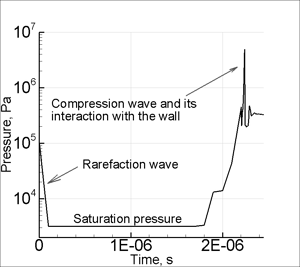

In many cases, cavitation is the reason for the decrease in the efficiency of various hydraulic devices, the operating principle of which is based on the movement of the working medium (liquid) under high pressure drops. Detailed information on the structure of the forming cavitation flows is often important for the design and optimization of hydraulic devices. However, a detailed study of such flows by measuring their local characteristics (and obtaining 2D/3D distributions) in a physical experiment is associated with significant difficulties due to the small spatial and temporal scales of the processes occurring. Therefore, at present, due to the intensive development of available computing power, numerical calculations are becoming an increasingly promising approach to studying the spatial distribution of key physical quantities in cavitation phenomena. Modeling the collapse of a spherical bubble located near a flat solid wall is one of the classical model problems relevant to the well-known problem of cavitations erosion. This problem is considered in this paper. The results of numerical calculations presented in the work were obtained in the OpenFOAM software package in a two-dimensional (axisymmetric) non-stationary formulation.
сavitation,
bubble collapse near a wall,
barotropic model,
OpenFOAM,
compression and rarefaction waves,
cumulative jet
Cavitation is the reason for degradation of the performance of technical devices that involve high speed liquid flows. Detailed information on structure of cavitating liquid flow is of key importance for design of such devices. But experimental study of these flows is a severe problem due to extreme flow parameters and very small spatial and temporal scales. That is why numerical simulation became an efficient tool of investigation of the detailed flow structure. Modelling of the collapse of a bubble located in the proximity of a solid wall is of particular interest from the point of view of cavitation erosion analysis. A quasi-homogeneous model of cavitating flows is formulated based on the assumptions of mechanical and thermodynamic equilibrium between the liquid and vapor phases. Numerical investigation is carried out for the unsteady compressible flow developing in the process of single vapor bubble collapse. The results of the numerical simulations presented in this work have been obtained using the CFD toolbox OpenFOAM in unsteady axisymmetric arrangement.
Lauterborn and co-workers (Journal of Fluid Mechanics, 1989) were, probably, the first who carried out a detailed experimental investigation of bubble collapse near a solid wall. They used high-speed photography to visualize the propagation of waves and the development of jets. Experimental study of these processes is very difficult because of extremely small spatial and temporal scales. That is why numerical simulation became an efficient tool of investigation of the detailed flow structure in the problems related to cavitation.
The first numerical results on the collapse of a single spherical bubble near a solid wall were presented by Plesset and Chapman (Journal of Fluid Mechanics, 1971). Later, the results from this work were used as a benchmark. These studies did not take into account the compressibility of the liquid phase which did not allow to observe the compression waves propagating in the liquid. Johnsen and Colonius (Journal of the Acoustical Society of America, 2008) considered compressible liquid and studied structure of the flow induced by bubble collapse, but they neglected phase transition effect.
In the present study both compressibility of the liquid and phase transition are taken into account. The goal is to get deep insight into the key mechanisms of cavitation bubble collapse near a solid wall. The implemented approach is based on the following main assumptions. It is assumed that cavitating liquid represents a homogeneous barotropic mixture. Interface between liquid and vapor phases is not captured, and the mass and momentum conservation equations are solved through the entire mixture. Heat transfer is neglected and the energy equation is not solved. Phase transition is described as an equilibrium process which takes place instantaneously at equilibrium saturation conditions.
As a result, non-monotonic profiles of the wall pressure were obtained and mechanisms of formation of such profiles were elucidated and explained. Formation of the cumulative jet was reproduced as well. The velocity distributions demonstrated the expected asymmetric scenario of bubble collapse near the wall. The time moment of the pressure peak at the epicenter corresponds to moment when the jet is impinging onto the wall. Both the jet and the compression waves bring their contribution into the resulting wall loading. Detailed parameter study including variation of the initial distance from the bubble center to the wall could provide more information and is therefore considered as a possible next step, as well as consideration of non-condensable gas effect.



